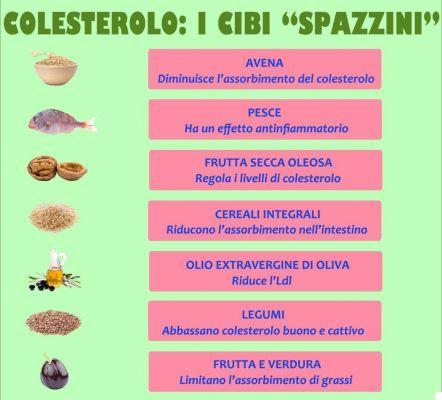
Oats
It is an excellent source of beta glucan, a plant fiber, which decreases the absorption of cholesterol. An analysis (published in the British Journal of Nutrition), made taking into consideration 58 clinical studies, concluded that oats reduce both the "bad" fraction (Ldl) and the other "not good" (no-Hdl) fractions. .
Eat it: 3-4 times a week.
Serving size: 30-40 g of flakes or grains.
Fish
- Omega 3, contained in the blue and salmon, exert a positive action on the metabolism of fats, because they reduce triglycerides, total cholesterol and Ldl. Also, they have a anti-inflammatory effect which keeps the arteries elastic.
Eat it: 2-3 times a week preferring the blue one.
Serving size: 150 g.
Whole grains
Unlike the refined ones, they contain fibers and phytosterols, excellent "scavengers" of cholesterol because of it decrease intestinal absorption. Whole grains are also rich in niacin (or Vitamin B3) which intervenes in the metabolism of fats by reducing triglycerides.
Eat them: everyday.
Serving size: 70-80 g (rice, spelled, barley ...), 50 g (bread).
Oily dried fruit
Thanks to fiber, Omega 3 fatty acids (found mainly in walnuts) and phytosterols, it contributes to regulate cholesterol levels. A study published in the Archives of Internal Medicine showed that after a few weeks of regular consumption, dried fruit cuts the LDL by 5-7% and increases the HDL by 8%.
Eat it: 1 time a day.
Serving size: 30 g.
Legumes
It has been amply demonstrated how, thanks to the fibers, their frequent consumption leads to a significant reduction in total and Ldl cholesterol. Among all the legumes, thea soia, thanks to its lecithins (a type of fat) has an edge.
Eat them: 5-7 times a week.
Serving size: 30 g (dry seeds); 100 g (fresh seeds or sprouts).
Extra virgin olive oil
There are countless studies documenting his benefits. The monounsaturated fatty acids (primarily oleic) of which it is rich act almost like a drug in reducing the LDL. Not to mention the other valuable nutrients it contains, such as Vitamin E, antioxidant that protects breasts and prostate.
Eat it: every day.
Serving size: 2 tablespoons, equal to about 20 g (if you consume more, you risk gaining weight).
Fruits and vegetables
Due to their quantity of fibers, they are able to "incorporate" fats and limit their absorption. But there is more: red-purple fruits and vegetables (berries, aubergines, black grapes, blood oranges) are rich in precious anthocyanins antioxidants which counteract the formation of plaques inside the arteries.
Eat it: 5 times a day.
Serving size: 150-200 g.


























